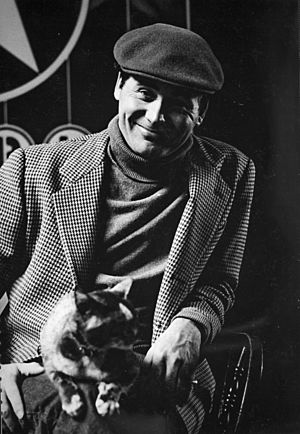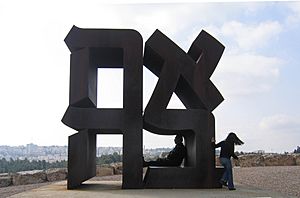Robert Indiana facts for kids
Quick facts for kids
Robert Indiana
|
|
|---|---|

Robert Indiana. Photo by Dennis Griggs
|
|
| Born |
Robert Clark
September 13, 1928 New Castle, Indiana, U.S.
|
| Died | May 19, 2018 (aged 89) Vinalhaven, Maine, U.S.
|
| Nationality | American |
| Education | Herron School of Art and Design, Arsenal Technical High School, Art Institute of Chicago, Skowhegan School of Painting and Sculpture, Edinburgh College of Art |
| Occupation | Artist, theatrical set designer and costume designer |
|
Works
|
LOVE |
| Movement | Pop art, Hard-edge painting |
Robert Indiana (born Robert Clark; September 13, 1928 – May 19, 2018) was a famous American artist. He was known for his connection to the pop art movement. Pop art uses images from popular culture, like advertisements and comic books.
His most famous artwork is the word LOVE. He first made it in 1964 as a card for his friends. In 1965, the Museum of Modern Art asked him to design their Christmas card. Indiana sent them several versions of his LOVE image. They chose a bright red, blue, and green one. It became one of the museum's most popular cards ever!
Indiana kept making his LOVE series. In 1966, he created his first LOVE sculpture from aluminum. By 1970, he made a huge LOVE sculpture from a special kind of steel called Cor-Ten steel. This large sculpture is now at the Indianapolis Museum of Art.
Besides being a painter and sculptor, Indiana also made posters and prints. He even designed stage sets and costumes for an opera called The Mother of Us All. His art has been shown in many exhibitions worldwide. You can find his work in major museums like the Museum of Modern Art in New York and the Tate Modern in London.
Contents
Who was Robert Indiana?
Robert Indiana was born Robert Clark in New Castle, Indiana. He was adopted as a baby by Earl Clark and Carmen Watters. After his parents divorced, he moved to Indianapolis to live with his father. He went to Arsenal Technical High School from 1942 to 1946. He was the top student in his class!
After serving three years in the United States Army Air Forces, Indiana went to art school. He studied at the Art Institute of Chicago and other schools in Maine and Scotland. In 1954, he came back to the United States and settled in New York City.
In New York, he met another artist named Ellsworth Kelly in 1956. Kelly helped him find an art studio. There, he met other artists like Agnes Martin. In 1958, he changed his last name to Indiana, honoring his home state. His art career really took off in the early 1960s. A famous art collector, Alfred H. Barr Jr., bought one of his paintings for the Museum of Modern Art.
In 1969, Indiana visited an island called Vinalhaven in Maine. He liked it so much that he started renting a space in an old building called "The Star of Hope." This building belonged to a group called the Odd Fellows. Indiana felt a special connection to the Odd Fellows because their symbol had three interlocking links. He said, "The three links of course are truth and friendship, and the important link in the middle just happens to be love. So I think I was fated to end my life in an Odd Fellows Lodge." He bought the building in 1973 and moved there permanently in 1978.
Robert Indiana became very private in his later years. He passed away at his home in Vinalhaven, Maine on May 19, 2018, at the age of 89.
What kind of art did Robert Indiana make?
Indiana's art often used simple, strong words. His work explored ideas about language, American identity, and his own life story. He often used words and styles from highway signs and roadside attractions. This made his art look bold and full of energy. Some of his most famous word artworks include EAT, DIE, HUG, ERR, and, of course, LOVE.
For his EAT series, the word EAT would glow in paint or light bulbs. A big moment in his career was when architect Philip Johnson asked him to create an EAT sign for the 1964 New York World's Fair. The sign was turned off soon after the fair opened because visitors thought it was a restaurant!
Indiana also made huge sculptures that you can see all over the world. These include LOVE, Imperial LOVE, LOVE Wall, AHAVA (which means love in Hebrew), AMOR (love in Latin), and ONE Through ZERO (The Ten Numbers). After the September 11 attacks in 2001, Indiana created a series of Peace Paintings.
He also designed sets and costumes for plays. He was even in a movie by Andy Warhol called Eat (1964). In this 45-minute film, Indiana is shown eating a mushroom.
His series of large sculptures showing the numbers zero through nine, called ONE Through ZERO (The Ten Numbers), has been shown in many cities since 1980.
The Story of LOVE
Indiana's most famous image is the word LOVE. It's written in capital letters, arranged in a square, with the letter "O" tilted sideways. He first used this idea in poems he wrote in 1958. The first paintings about love were 4-Star Love (1961) and Love Is God (1964).
The art historian Susan Elizabeth Ryan said that the idea for LOVE might have come from a different four-letter word that Indiana was working with. She also mentioned that Indiana and his partner, Ellsworth Kelly, used to exchange small sketches. Kelly would paint colors, and Indiana would add big words on top.
The red, blue, and green LOVE painting was chosen for the Museum of Modern Art’s Christmas card in 1965. Robert Indiana said it was "the most profitable Christmas card the museum ever published."
Indiana said he chose these colors because his father worked at a Phillips 66 gas station. The gas station's colors were green and red. He described the original colors as "the red and green of that sign against the blue Hoosier sky." However, some people also believe the colors were inspired by a painting called Red Blue Green (1963) by Ellsworth Kelly, his former partner.
Indiana said, "Ellsworth Kelly introduced me to Hard-Edge and was a great influence on my work."
In 1973, the United States Postal Service asked Indiana to design a stamp. He created the eight-cent LOVE stamp, which was released before Valentine's Day. This stamp became very popular, with over 425 million copies printed in two years!
LOVE in Hebrew
In 1977, Robert Indiana created a Hebrew version of his LOVE sculpture. It uses the four-letter Hebrew word Ahava (אהבה), which also means "love." This sculpture, made of Cor-Ten steel, is in the Art Garden at the Israel Museum in Jerusalem.
Google's tribute
For Valentine's Day in 2011, Google honored Indiana's LOVE artwork. They displayed his LOVE image in place of their usual logo on their search engine website.
Where can you see Robert Indiana's art?
Robert Indiana's first solo art show in New York was in 1962. His work has been shown in many galleries around the world.
From July to September 2008, a big exhibition called Robert Indiana a Milano took place in Milan, Italy. The main show was at the Pavilion of Contemporary Art, and other artworks were displayed in public squares.
In 2013, the Whitney Museum of American Art held a large show of his work called Robert Indiana: Beyond LOVE. This exhibition also traveled to the McNay Art Museum in Texas.
The first major show of Indiana's sculptures in the United Kingdom opened in March 2022 at Yorkshire Sculpture Park. It showed 60 years of his amazing work.
Museum Collections
Today, you can find Robert Indiana's artworks in many museums around the world. Some of these include:
- Museum of Modern Art, New York
- Whitney Museum of American Art, New York
- Metropolitan Museum of Art, New York
- National Gallery of Art, Washington D.C.
- San Francisco Museum of Modern Art, California
- Indianapolis Museum of Art, Indiana
- Tate Modern, London
- Israel Museum, Jerusalem
And many, many more!
Images for kids
See also
 In Spanish: Robert Indiana para niños
In Spanish: Robert Indiana para niños






